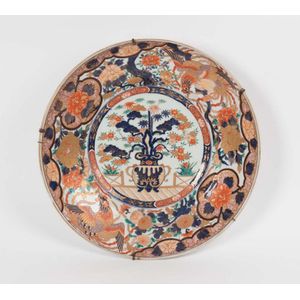Yokoyama Satsuma Dish with Rakan and Dragon
You must be a subscriber, and be logged in to view price and dealer details.
Subscribe Now to view actual auction price for this item
When you subscribe, you have the option of setting the currency in which to display prices to $Au, $US, $NZ or Stg.
- Cartouche - An ornamental panel in the form of of a shield, oval or rectangular scroll with curling edges. It may be carved into the back of a chair or the top of a sideboard, or present on a piece of silver or jewellery, and contain the initials of the original owner, heraldic symbols, or some other inscription, such as the details of a presentation.
In ceramics the term defines the central area of a vase or similar with a decorative border in one of the shapes above, into which a decorative scene or figures have been painted. - Chevron Motif - In jewellery, a chevron is a V-shaped pattern or design that is often used to create a bold and striking visual effect, and as a symbol of strength, power and protection.. It is a classic motif used in many different styles of jewellery and can be seen in various forms such as on a ring, earrings, bracelets, and necklaces. It can be created with precious or semi-precious stones, pearls, or enamel. It can be found in different forms such as engraved or inlaid or beaded.
In ceramics the pattern is often used in decorative pottery and porcelain pieces, such as vases, bowls, plates and figurines. The chevron pattern can be created by using different colored glazes or by hand-painting the design onto the piece. It is also commonly found in the form of embossing or intaglio in decorative ceramic objects. This pattern can be seen as a popular design choice in Art Deco and Art Nouveau style of ceramics.
This chevron pattern can also be found in many different types of furniture, such as tables, chairs, chests of drawers, and cabinets. A common place to find chevron pattern is in a herringbone pattern, which is made up of repeating V-shaped patterns. The chevron pattern can be created by using different types of wood, inlaying or by using different colors of stain. It is also commonly found in the form of a veneer. This pattern can be seen as a popular design choice in mid-century modern, Art Deco, and contemporary style furniture. - Mon - A mon is a Japanese heraldic emblem, indicating the status or the family of the owner, similar to a family crest. Nowadays almost all Japanese families and many businesses have a mon.
In decorative arts, mon are used as a decorative element on a vase, plate, bowl or item of furniture.
This item has been included into following indexes:
- Japanese ceramics, item types - other 2,525
-
Satsuma (Japan), item type
- dishes 225
- other items 2,034
Visually similar items

A large Japanese Imari charger, Meiji period, finely painted with central vase surrounded by phoenix, 52 cm diameter

An antique Japanese Imari plate, probably Meiji period (1868-1912), the plate with a central cobalt roundel with foliate and tendril designs enclosed by a wide brocaded border with reserves, patterns and emblematic floral motifs in emerald, iron red, orang

Japanese Satsuma plate, showing scroll preparation scene, 31 cm diameter

A large Japanese imari plate, Meiji period (1868-1912), decorated with flowers and rocks, 52 cm diameter
